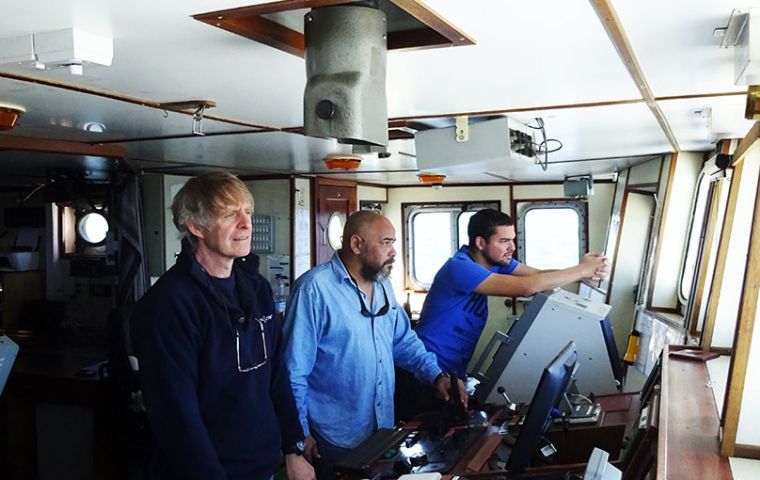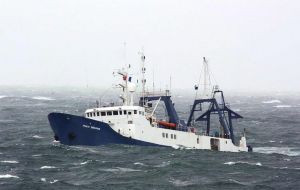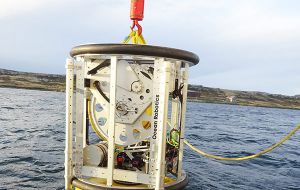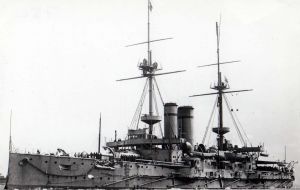MercoPress. South Atlantic News Agency
Battle of the Falklands 1914: the search for the lost German battleships
 Mensun Bound and captain Roger White on the bridge of RSV Endeavour. The 104 day search was much conditioned by the frustrating bad weather
Mensun Bound and captain Roger White on the bridge of RSV Endeavour. The 104 day search was much conditioned by the frustrating bad weather  The ship chartered for the project was the 55.99m RSV Endeavour owned by Seaway-Offshore Ltd. A vessel with an unusual history as Colonel Templar
The ship chartered for the project was the 55.99m RSV Endeavour owned by Seaway-Offshore Ltd. A vessel with an unusual history as Colonel Templar  The main search tool was a deep-water, multi-beam, side-scan sonar, or ‘fish’, that was towed behind the ship at the end of some 4,000 to 6,000 m of cable.
The main search tool was a deep-water, multi-beam, side-scan sonar, or ‘fish’, that was towed behind the ship at the end of some 4,000 to 6,000 m of cable.  HMS Canopus was a pre-dreadnought battleship of the Royal Navy missed the Battle of Coronel, but fired the first shots of the Battle of the Falklands
HMS Canopus was a pre-dreadnought battleship of the Royal Navy missed the Battle of Coronel, but fired the first shots of the Battle of the Falklands Last December, in a spirit of remembrance and reconciliation, and in the presence of the descendants of the fighting admirals, the Falkland Islands commemorated the 100th anniversary of the Battle of the Falklands, an action that sent six ships to the bottom and claimed well over 2000 lives.
The Battle of the Falklands was the most decisive naval engagement of the war, the only all-cruiser fleet action ever to have been fought, and the last major naval clash in which the belligerents did not have to worry about submarines, aeroplanes, mines or missiles. For the Germans (who had just triumphed over the British off Coronel) it was their worst defeat at sea since the foundation of their navy; for the British it was their greatest victory since Trafalgar.
As part of the Commemorations FIMA Trustee Mensun Bound led an expedition to try to find the wrecks. Their precise objectives were to locate Admiral Graf von Spee’s flagship, the Scharnhorst, and her sister ship, the Gneisenau, and then to conduct an archaeological survey of each to establish their dispositions and general states of preservation. Because both vessels are war graves, it was decided that all work would be conducted remotely, in other words nothing would be touched nor anything taken. Had the wrecks been found the intention was to present the findings to Falkland Islands Government with the request that they be considered for designation as National Monument Sites, thus ensuring their protection from depredation.
Five years of research in various museums and archives of Britain, Germany and the Falklands, defined a search area that was situated on the Falklands’ shelf, some 80 miles SE of Stanley in depths of between 1200 and 1500 m.
Mensun, whose career was spent as the ‘Triton Fellow in Maritime Archaeology’ at the University of Oxford, reports that their procedure was to focus first on the positions they had found in the archives, and from there expanded outwards in all directions. Their main search tool was a deep-water, multi-beam, side-scan sonar, or ‘fish’, that was towed behind the ship at the end of some 4,000 to 6,000 m of cable. As the fish proceeded through the water it emitted a downward pulse which was reflected back off the terrain and any distinguishing features it might contain. The intensity of the acoustic echo was processed and then used to ‘paint’ a picture of the seabed. The challenge for those in the Control Room was to hold the fish in position just 40-50 m above the seabed without driving it into the bottom or any sudden rock outcrops. This never happened, but on one occasion in March the cable snapped and a valuable fish was lost.
The ship chartered for the project by the FIMHT was the 55.99m RSV Endeavour owned by the marine salvage and engineering company Seaway-Offshore Ltd. It was a vessel with an unusual history for, in a previous life, as the Colonel Templar, it had been used by the British Military as a Cold War spy ship. Disguised as an innocent deep-sea trawler, one of its roles had been to seek out and shadow Soviet submarines. Several of the features from this period were still there, including a small opening, or moon-pool, in the hull through which hydrophones and other transducers were lowered into the water.
The main problem faced by the team was the accuracy of the coordinates that had been recorded in the logs and official reports of the day by the people who were there. Heavy clouding during the afternoon of the battle made sextant readings difficult, if not impossible, which meant they were relying largely on ‘dead reckoning’ (i.e. the distance and direction since their last navigational fix) to establish their positions. The two main vessels in the British squadron, were the battle cruisers Invincible and Inflexible, and they appear not to have deployed their log-lines, and there was also considerable compass deviation. These factors, together with all the course changes during the chase and the action, would have meant significant cumulative error in their calculations. In other words the men on the bridge did not know exactly where they were, and this is not surprising for, in battles of total destruction, positioning was hardly their foremost concern. Indeed, the more candid captains of Kent and Glasgow prefixed their recorded latitudes and longitudes with the word ‘approximate’.
During the course of the 104 day search the team covered over half of their target area but found nothing. ‘The most frustrating factor’, said Mensun, who has been directing maritime expeditions and excavations all his working life, ‘was the weather. I have never known anything like it. One storm after another. Even though we could work in wave heights of up to 3.5 m, almost 60 per cent of our time was spent at shelter in Stanley Harbour’.
Despite their disappointment, the team is not giving up and discussions are currently taking place regarding a second campaign.




Top Comments
Disclaimer & comment rules-

-

-

Read all commentsA very interesting battle.Hope they find the ships.
Oct 28th, 2015 - 09:24 am 0Good hunting !
Here's a clue: they are on the ocean floor!
Oct 28th, 2015 - 11:09 am 0:o)
I find those pre-WWI ships fascinating, good luck with the search.
Oct 28th, 2015 - 02:55 pm 0Commenting for this story is now closed.
If you have a Facebook account, become a fan and comment on our Facebook Page!